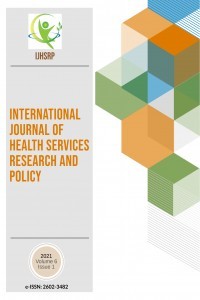RELATIONSHIP BETWEEN SELF-REPORTED HAND HYGIENE BELIEFS AND HAND HYGIENE PRACTICES IN NURSING STUDENTS: A STRUCTURAL EQUATION MODELING
RELATIONSHIP BETWEEN SELF-REPORTED HAND HYGIENE BELIEFS AND HAND HYGIENE PRACTICES IN NURSING STUDENTS: A STRUCTURAL EQUATION MODELING
hand hygiene, nursing, students, beliefs, practices nosocomial infection,
___
- [1] Pittet, D., Simon, A., Hugonnet, S., Pessoa-Silva, C., Sauvan, V., Perneger, T., “Hand hygiene among physicians: Performance, beliefs, and perceptions,” Annals of Internal Medicine, 141(1), 1–8, 2004. Doi: 10.7326/0003-4819-141-1-200407060-00008
- [2] WHO, “Nurses are the heart of our health-care system," World Health Organization, 2020. https://www.euro.who.int/en/health-topics/health-emergencies/coronavirus-covid-19/news/news/2020/5/nurses-are-the-heart-of-our-health-care-system-shoshy-goldberg,-government-chief-nursing-officer,-israel
- [3] Hugonnet, S., Pittet, D., “Hand hygiene—beliefs or science?,” Clinical Microbiology and Infection, 6(7), 348–354, 2000. Doi: 10.1046/j.1469-0691.2000.00104.x
- [4] Akyol, A. D., “Hand hygiene among nurses in Turkey: Opinions and practices,” Journal of Clinical Nursing, 16(3), 431–437, 2007. Doi: 10.1111/j.1365-2702.2005.01543.x
- [5] Karaoğlu, M. K., Akın, S., “Evaluation of Nurses’ Views about Hand Washing Habits and Hand Hygiene Compliance Rates,” Journal of Education and Research in Nursing, 16(1), 33–40, 2019. Doi: 10.5222/HEAD.2019.033
- [6] Van de Mortel, T., Apostolopoulou, E., Petrikkos, G., “A comparison of the hand hygiene knowledge, beliefs, and practices of Greek nursing and medical students,” American Journal of Infection Control, 38(1), 75–77, 2010. Doi: 10.1016/j.ajic.2009.05.006
- [7] Van de Mortel, T., “Development of a questionnaire to assess health care students’ hand hygiene knowledge, beliefs and practices,” Australian Journal of Advanced Nursing, 26(3), 9–16, 2009. https://pdfs.semanticscholar.org/c170/4775ad0cddbe2c74aa94fc703a056eed4d1e.pdf
- [8] Moret, L., Tequi, B., Lombrail, P., “Should self-assessment methods be used to measure compliance with handwashing recommendations? A study carried out in a French university hospital,” American Journal of Infection Control, 32(7), 384–390, 2004. Doi: 10.1016/j.ajic.2004.02.004
- [9] Larson, E. L., Aiello, A. E., Cimiotti, J., “Assessing nurses’ hand hygiene practices by direct observation or self-report.,” Journal of Nursing Measurement, 12(1), 77–85, 2004. http://www.ncbi.nlm.nih.gov/pubmed/15916321
- [10] Aiello, A. E., Malinis, M., Knapp, J. K., Mody, L., “The influence of knowledge, perceptions, and beliefs, on hand hygiene practices in nursing homes,” American Journal of Infection Control, 37(2), 164–167, 2009. Doi: 10.1016/j.ajic.2008.04.258
- [11] Cebeci, F., Gürsoy, E., Tekingündüz, S., “Examination of The Tendency for Nursing Malpractice and Affecting Factors,” Journal of Anatolia Nursing and Health Sciences, 15(3), 188–196, 2012. https://dergipark.org.tr/tr/pub/ataunihem/issue/2658/34258
- [12] Ertek, M., “Hospital infections:The data of Turkey,” Istanbul University Cerrahpasa Medical Faculty Continuous Medical Education Activities, Symposium Series, 60(1), 9–14, 2008. http://ctf.edu.tr/stek/pdfs/60/6001.pdf
- [13] Aylaz, R., Şahin, F., Yıldırım, H., “Determination of Knowledge Level Related to the Subject of Hospital Infection of the Nurses,” Balıkesir Journal of Health Sciences, 7(2), 67–73, 2017. https://dergipark.org.tr/en/download/article-file/544818
- [14] Whitby, M., McLaws, M. L., Ross, M. W., “Why Healthcare Workers Don’t Wash Their Hands: A Behavioral Explanation,” Infection Control & Hospital Epidemiology, 27(5), 484–492, 2006. Doi: 10.1086/503335
- [15] Karadağ, M., Pekin Iseri, Ö., Yildirim, N., Etikan, İ., “Knowledge, Beliefs and Practices of Nurses and Nursing Students for Hand Hygiene,” Jundishapur Journal of Health Sciences, 8(4), 1–7, 2016. Doi: 10.17795/jjhs-36469
- [16] Barrett, R., Randle, J., “Hand hygiene practices: nursing students’ perceptions,” Journal of Clinical Nursing, 17(14), 1851–1857, 2008. Doi: 10.1111/j.1365-2702.2007.02215.x
- [17] Lymer, U. B., Richt, B., Isaksson, B., “Blood exposure: factors promoting healthcare worker’s compliance with guidelines in concern with risk,” Journal of Clinical Nursing, 13(5), 547–554, 2004. Doi: 10.1111/j.1365-2702.2004.00897.x
- [18] Van de Mortel, T., Kermode, S., Progano, T., Sansoni, J., “A comparison of the hand hygiene knowledge, beliefs, and practices of Italian nursing and medical students,” Journal of Advanced Nursing, 68(3), 569–579, 2012. Doi: 10.1111/j.1365-2648.2011.05758.x
- [19] Al-Khawaldeh, O., Al-Hussami, M., Darawad, M., “Influence of Nursing Students Handwashing Knowledge, Beliefs, and Attitudes on Their Handwashing Compliance,” Scientific Research Publishing, 7, 572–579, 2015. Doi: 10.4236/health.2015.75068
- [20] Kiprotich, K., Kaminga, Chiwanda, A., Kessi, M., Honghong, W, “Observed and Self-reported Hand Hygiene Compliances and Associated Factors among Healthcare Workers at a County Referral Hospital in Kenya,” Research Square, 1–16, 2020. Doi: 10.21203/rs.3.rs-79985/v1
- [21] Karadağ, M., Yıldırım, N., Pekin İşleri, Ö, “The validity and reliability study of Hand Hygiene Belief Scale and Hand Hygiene Practices Inventory,” Cukurova Medical Journal, 41(2), 271–284, 2016. Doi: 10.17826/cutf.206317
- [22] Okgün Alcan, A., Dolgun, E., “Student Nurses’ Hand Hygiene Beliefs and Practices,” Turkish Journal of Family Medicine and Primary Care, 13(3), 279–286, 2019. Doi: 10.21763/tjfmpc.609778
- [23] Hunt, D. C., Mohammudally, A., Stone, S. P., Dacre, J., “Hand-hygiene behaviour, attitudes and beliefs in first year clinical medical students,” Journal of Hospital Infections, 59(4), 371–373, 2005. Doi: 10.1016/j.jhin.2004.09.002
- [24] Bayram, Ş. B., Calışkan, N., Gülnar, E., Aydın, M., “The Effect of Planned Education on Hand-Washing Beliefs And Practices of Nursing Students: Non-Participant Observation Study With Pre-Post Test Design,” Gazi Journal of Health Sciences, 4(2), 20–30, 2019. https://dergipark.org.tr/tr/download/article-file/903908
- [25] Al-Hussami, M. O., Darawad, M. W., Almhairat, I., “Predictors of compliance hand hygiene practice among healthcare professionals.,” Healthcare Infection, 16, 79–84, 2011. https://idhjournal.com/article/S1835-5617(16)30141-7/pdf
- Yayın Aralığı: Yılda 3 Sayı
- Başlangıç: 2016
- Yayıncı: Rojan GÜMÜŞ
Mustafa DURMUŞ, Halil ALKAN, Necmettin ÇİFTCİ
SEXUAL ORIENTATION MYTHS: DOES THEOLOGICAL EDUCATION AFFECT SEXUAL ORIENTATION MYTHS?
EXAMINATION OF COVID-19 FEAR IN TERMS OF ITS DEFINING CHARACTERISTICS
Sevim ÇİMKE, Dilek YILDIRIM GÜRKAN, Derya ESENKAYA
THE RELATIONSHIP BETWEEN HUMOR STYLE AND DEATH ANXIETY OF PALLIATIVE CARE PATIENTS
ATTITUDES OF PEDIATRIC NURSES AND TEACHERS TOWARDS CHILDREN’S RIGHTS AND THEIR PARENTAL ATTITUDES
Esra TURAL BÜYÜK, Emel ODABAŞOĞLU, Hatice UZŞEN, Merve KOYUN
DOES THE FREQUENCY OF ACUTE CHOLECYSTITIS DECREASE DURING THE RAMADAN MONTH?
Murat SEYİT, Atakan YILMAZ, Sevda YILMAZ, Mert ÖZEN
Melda SOYSAL TOMRUK, Alp Tunca YAPICI, Nihal GELECEK, Orhan KALEMCİ
Heather LEGGETT, Frank FOX, Karen VİNALL COLLİER, Julia CİSKAR, Evangelos ZORMPAS, Helen WHELTON, Gail DOUGLAS
